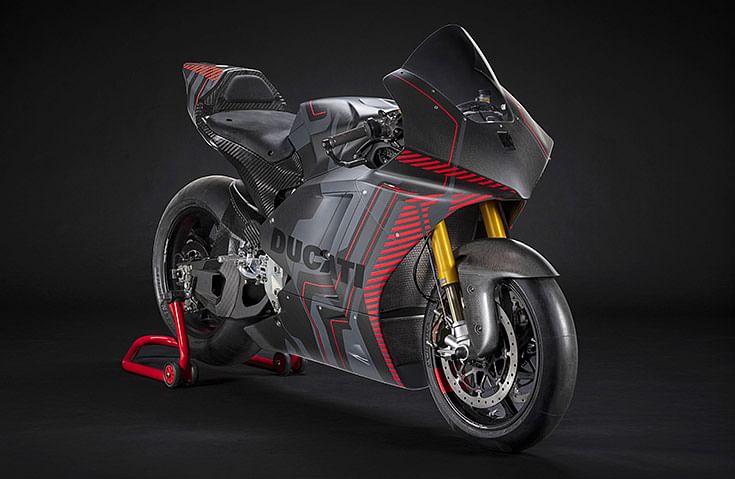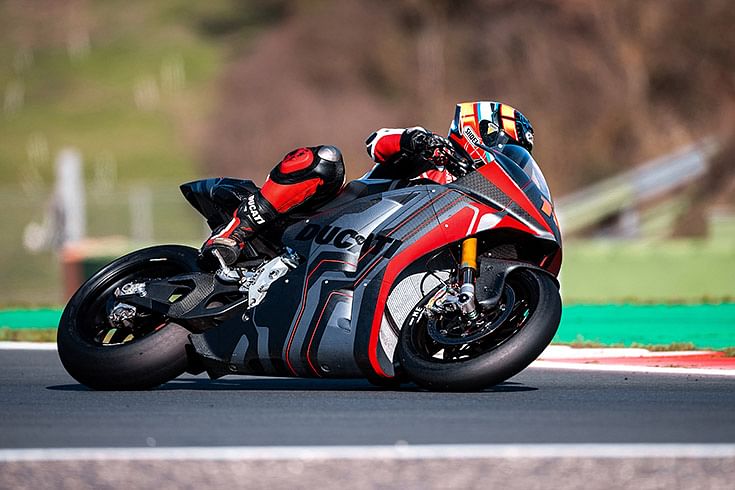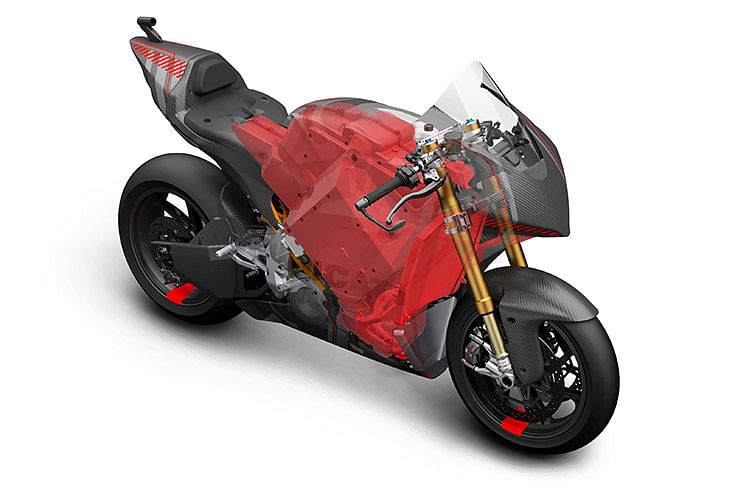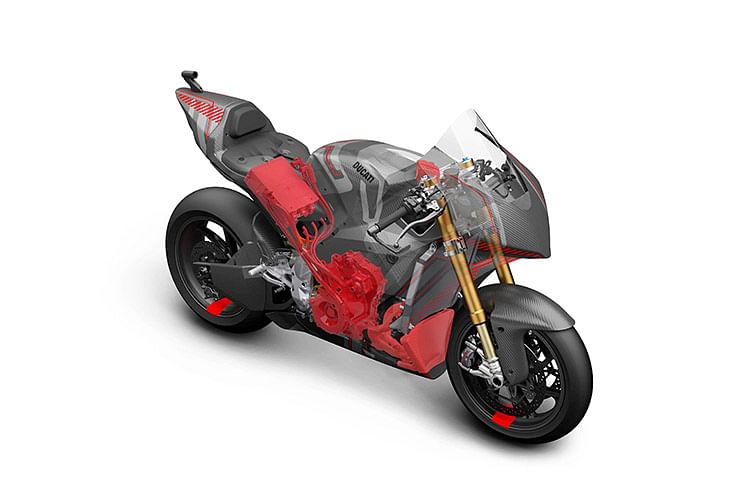Revealed: Tech highlights of Ducati’s first electric motorcycle
Close collaboration between the R&D departments of Ducati and Ducati Corse sees the MotoE integrate technical solutions never adopted before for battery pack, motor and inverter.
Ducati has released technical details of its MotoE project in a video in which the prototype is illustrated by the team that has overseen its creation and is following its development.
‘V21L’ in Borgo Panigale identifies Ducati’s first electric motorcycle, a prototype that starting from 2023 will compete in the FIM MotoE World Cup, of which the Bologna-based motorcycle manufacturer will be a partner as sole supplier with 18 bikes on the track during each race weekend.
Ducati's experience in the FIM Enel MotoE World Cup will be a fundamental support for product R&D. The goal is to create a Ducati electric vehicle for road use that is sporty, light, exciting and able to satisfy all enthusiasts.
The MotoE project has strategic relevance for Ducati since it makes it possible to develop expertise for the future while maintaining the racetrack-driven approach that has always fuelled the DNA of the Bologna-based manufacturer.

With the Ducati MotoE, the aim is to create a Ducati electric vehicle for road use that is sporty, light, exciting and able to satisfy all enthusiasts.
To produce the MotoE prototype, the iconic bike maker put together a team that unites Ducati and Ducati Corse designers. The creation of the bike followed the procedure that is usually adopted for production bikes, triggering a close collaboration between the members of the team that led to new ways of thinking and designing, encouraged by such a technologically challenging project.
Ducati R&D took care of all the Project Management activities, together with the design and simulations on the electric powertrain, while the design of the MotoE was taken care by the Centro Stile Ducati which also created the livery of the bike. Ducati Corse, on the other hand, worked on the electronic parts design, on the software controls and strategies, on the simulations of the dynamics and aerodynamics of the motorcycle and finally on the bike assembly, testing and data acquisition processes.

The result to date is already satisfactory: the Ducati MotoE has a total weight of 225kg and maximum power and torque figures of 110 kW (150 hp) and 140 Nm respectively, which allowed it to reach a speed of 275 km/h on a circuit like Mugello (Italy).
Unique technical solutions
Ducati’s first electric motorcycle benefits from unique technical solutions. The battery pack is characterised by a shape specifically designed to follow the natural course of the middle area of the bike. The battery pack weighs 110kg and offers a capacity of 18 kWh with a 20-kW charging socket integrated into the tail. Inside there are 1,152 cylindrical cells of the ‘21700’ type.
The inverter, with a low weight of 5kg, is a unit derived from a high-performance model used in motor racing for electric vehicles, while the motor (21kg weight and a maximum rotation speed of 18,000rpm) was developed by a partner following the technical specifications provided by Ducati. The entire system is based on a voltage of 800V (with a fully charged battery pack) to maximize the output of the electric powertrain and, as a consequence, performance and range.

One of the most advanced technical solutions tested on the Ducati MotoE concerns the cooling system. The prototype components are in fact cooled by a particularly sophisticated and efficient liquid system with a double circuit designed to meet the different thermal needs of the battery pack and the motor/inverter unit. This guarantees extreme regularity of temperatures with important benefits in terms of consistency of performance but also in charging times. In fact, it is not necessary to wait for the battery pack to cool to start the process: the Ducati MotoE can be charged as soon as it enters the garage, and it takes about 45 minutes to recharge it up to 80% of its range.
The carbon fibre case of the battery pack also acts as a stressed part of the chassis, like what happens for the Ducati Panigale V4 engine, with an aluminium monocoque Front Frame for the front area weighing 3.7kg. The rear is composed of an aluminium swingarm weighing 4.8 kg with a geometry like that of the Ducati Desmosedici racing in MotoGP. The rear subframe, which integrates the tail and the rider seat, is made of carbon fibre.
 The suspension area features an Ohlins NPX 25/30 pressurized fork with 43 mm diameter upside-down tubes at the front, derived from the Superleggera V4, while an Öhlins TTX36 shock absorber is present at the rear and is fully adjustable. The steering damper is an adjustable Öhlins unit.
The suspension area features an Ohlins NPX 25/30 pressurized fork with 43 mm diameter upside-down tubes at the front, derived from the Superleggera V4, while an Öhlins TTX36 shock absorber is present at the rear and is fully adjustable. The steering damper is an adjustable Öhlins unit.
The Ducati MotoE’s braking system is supplied by Brembo. At the front it is composed of a double steel disc with a diameter of 338.5 mm of increased thickness, which has fins on the internal diameter with the aim of increasing the thermal exchange surface area and improve disc cooling in conditions of extreme use on the track. Two GP4RR M4 32/36 calipers with a PR19/18 radial master cylinder operate on this double disc. At the rear, the P34 caliper acts on a single disc unit 220 mm in diameter and 5 mm thick with a PS13 master cylinder. Teams can also choose to equip their bikes with an optional rear brake control positioned on the left handlebar, which the rider can use as an alternative to the pedal one.
RELATED ARTICLES
Autoliv Plans JV for Advanced Safety Electronics With China’s HSAE
The new joint venture, which is to be located strategically near Shanghai and close to several existing Autoliv sites in...
JLR to Restart Production Over a Month After September Hacking
Manufacturing operations at the Tata Group-owned British luxury car and SUV manufacturer were shut down following a cybe...
BYD UK Sales Jump 880% in September to 11,271 units
Sales record sets the UK apart as the largest international market for BYD outside of China for the first time. The Seal...






 By Autocar Professional Bureau
By Autocar Professional Bureau
 01 Jul 2022
01 Jul 2022
 9166 Views
9166 Views






















 Ajit Dalvi
Ajit Dalvi




